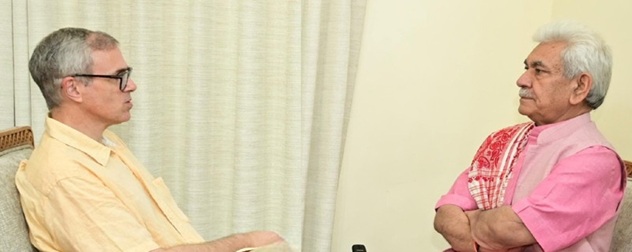Power Struggle in Jammu & Kashmir: L-G Manoj Sinha’s Expanding Control Over Bureaucracy Raises Concerns
Srinagar, April 3, 2025 – A fresh wave of political unease has engulfed Jammu and Kashmir as Lieutenant Governor (L-G) Manoj Sinha strengthens his hold over the region’s bureaucracy. The latest administrative reshuffle, which saw the transfer of 48 middle-rung officers, including magistrates, has sparked concerns over the delicate balance of power between the elected government and the L-G’s office.
The National Conference-led government, headed by Chief Minister Omar Abdullah, is grappling with a growing dilemma: how to retain administrative control in a system where the L-G’s authority appears to be expanding beyond its traditional remit.
The Business Rules Battle: Seeking Clarity Amid Confusion
In March 2025, the J&K government drafted a comprehensive set of Business Rules and submitted them to the Ministry of Home Affairs (MHA) through the L-G’s office. These rules aimed to clearly define the roles and responsibilities of the Chief Minister’s office, the Council of Ministers, and the Raj Bhavan under the framework of the J&K Reorganisation Act, 2019.
While the Act already grants the L-G substantial authority over the police and IAS officers, the elected government was pushing for increased control over Jammu and Kashmir Administrative Service (JKAS) officers and deputy commissioners. The intention was to ensure that administrative appointments align with the government’s policy framework, rather than being dictated by Raj Bhavan.
However, the L-G’s latest wave of transfers—executed unilaterally—has cast doubt over the efficacy of these proposed rules, signaling a further consolidation of power within his office.
Unprecedented Transfers and Their Implications
The recent transfer orders include more than a dozen magistrates, a move that has been interpreted by political observers as a strategic expansion of the L-G’s influence into critical administrative sectors, particularly the Revenue Department.
While the L-G’s office maintains that these transfers are routine administrative decisions, critics argue that such actions weaken the authority of the elected government, raising concerns over governance and autonomy.
The National Conference-led administration is reportedly considering formally lodging its objections with the MHA, citing an encroachment upon its jurisdiction.
Political and Administrative Fallout: A Brewing Confrontation?
The current tensions between the Chief Minister’s Office and the L-G’s Secretariat are not new. The two power centers have been at odds over bureaucratic appointments since the Omar Abdullah government assumed office in October 2024.
Earlier, the L-G’s attempt to transfer senior JKAS officer Vishesh Mahajan as Director of Tourism was blocked by the Chief Minister’s Office. Similarly, when the Chief Minister sought to retain Advocate General D.C. Raina, the Raj Bhavan declined the request, underscoring the growing administrative standoff.
While the National Conference-led government has so far remained cautious in its public responses, insiders suggest that the issue is far from settled. The ruling party may escalate the matter, either by mounting legal challenges or seeking direct intervention from the Union Government.
The Role of Civil Magistrates: A Key Flashpoint
One of the most contentious aspects of the recent transfers is the reassignment of magistrates. Traditionally, only Deputy Commissioners hold the authority of magistrates, while others are designated on a need-based basis for law-and-order situations.
By extending his influence over magistrate appointments, the L-G is effectively asserting control over key law enforcement mechanisms, further reducing the elected government’s operational control. This move is particularly concerning for the National Conference leadership, which sees it as an effort to systematically diminish the power of the Chief Minister’s Office.
Looking Ahead: Potential Scenarios for J&K’s Governance
With these latest developments, the following scenarios are possible:
1. Formal Intervention by the MHA
The J&K government may directly appeal to the Union Home Ministry, requesting a review of the L-G’s powers, particularly concerning bureaucratic appointments. However, given that J&K is a Union Territory, the MHA’s stance is likely to favor the L-G’s authority.
2. Legal Challenge by the J&K Government
If the conflict escalates, the National Conference-led administration may explore legal options to contest the L-G’s decisions in court. This could set the stage for a prolonged legal battle over governance in J&K.
3. Increased Political Polarization
As tensions between the L-G and the elected government continue to grow, political discourse in J&K could become more polarized. This might have implications for future elections and governance stability in the region.
4. A Compromise Approach
A negotiated settlement between the Chief Minister’s Office and the L-G could emerge as the most pragmatic resolution. However, such a compromise would require concessions from both sides, which, given the current political climate, may be difficult to achieve.
Bottom-Line: A Defining Moment for Jammu & Kashmir’s Governance
The power struggle between the L-G and the elected government is shaping up to be one of the most significant governance challenges in Jammu and Kashmir’s recent history. With the L-G asserting greater administrative control and the National Conference-led government pushing back, the future of governance in J&K hangs in the balance.
As this complex situation unfolds, one thing remains certain: the delicate balance of power in Jammu & Kashmir will continue to be a subject of intense scrutiny and debate in the months to come.



